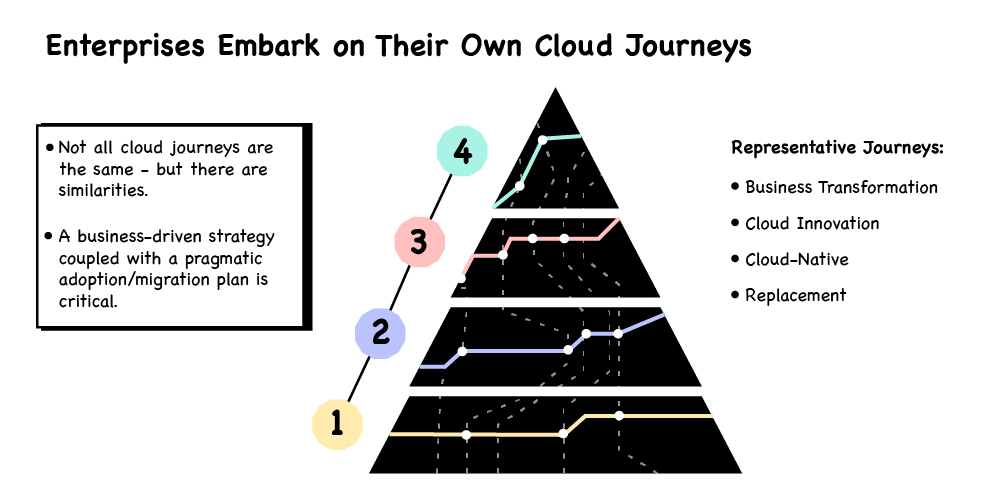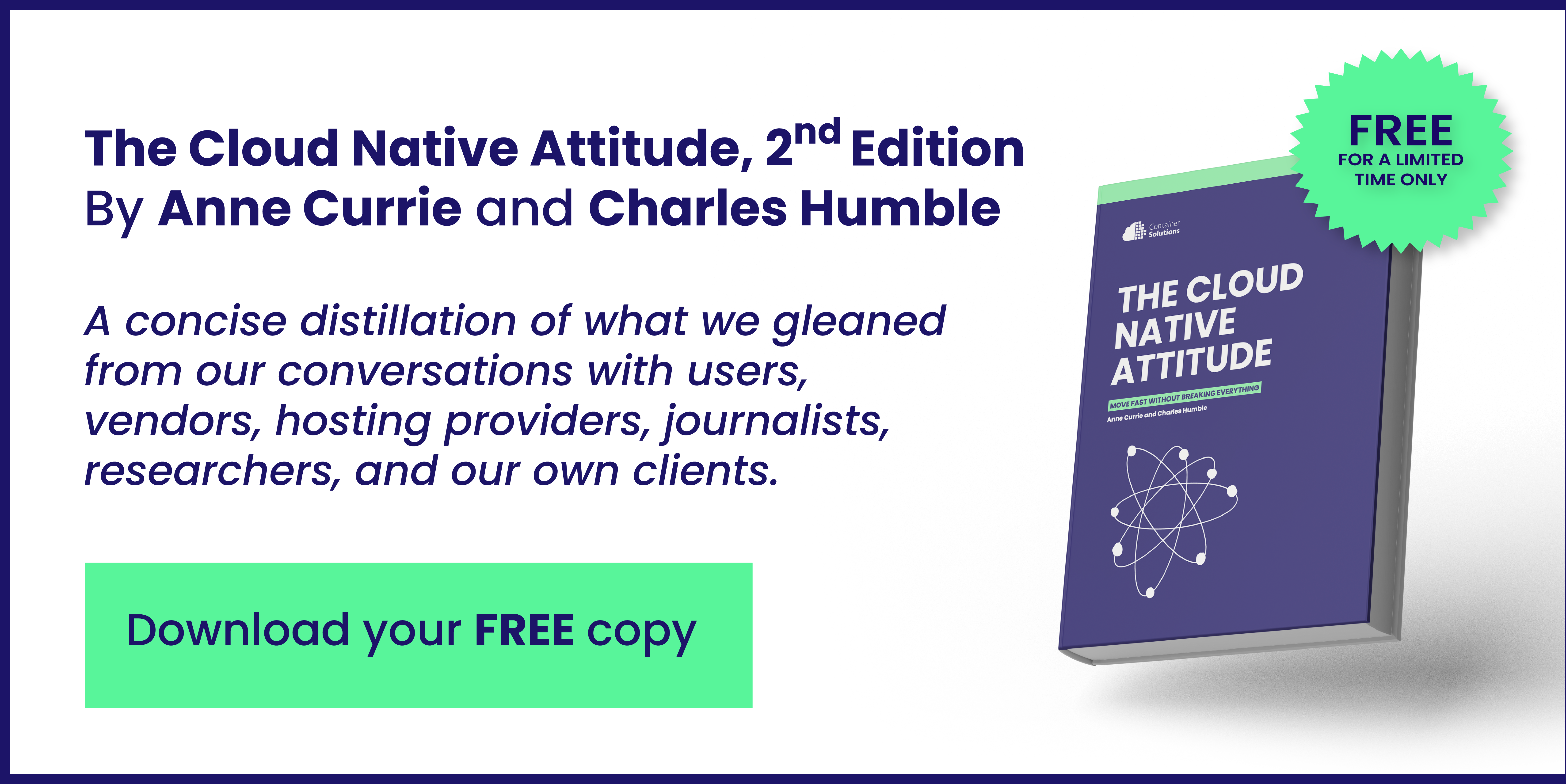Business strategy is very easy to get wrong. You’re trying to make sure your resources and assets are efficiently deployed and focussed on your end goal, and that’s hard. There’s no magic bullet that can help you both get the right strategy defined, and then successfully deliver on it, but there are many resources we’ve found that can help reduce the risk of failure.
Under the heading ‘The Future of Cloud’, Gartner recently ran a symposium for CIOs and IT executives including much discussion about strategies relating to Cloud and Cloud Native trends. At least two of the main talks (one, two) were centred around a five-year horizon, discussing where cloud adoption will be in 2027 compared to where it is now.
As part of those talks, Gartner referenced a useful pyramid-shaped visualisation of different stages of cloud adoption. It could be viewed as a more schematic version of our Maturity Matrix, which we use as part of our Cloud Native Assessments with clients.
In this article, we’re going to use the Gartner visualisation to talk about one of the biggest mistakes made in Cloud Native transformation strategies.
The pyramid
Gartner’s pyramid depicts four stages of cloud adoption from the perspective of business scope. These stages are shown as a hierarchy where the bottom layer represents the lowest dependency (“Technology Disruptor”) and the top layer represents the highest level business goal (“Business Disruptor”).
The four stages can be briefly summarised as:
- Cloud As Technology Disruptor
- The new base technology is adopted. For example, containerised applications, or a move to using a cloud service provider instead of a data centre.
- Cloud As Capability Enabler
- Now you have new technology in place, you can more easily build capabilities that may have been more difficult to achieve before, such as automated testing, or CI/CD.
- Cloud As Innovation Facilitator
- With new capabilities, you have the right environment to foster innovation in your business. This means you might, for example, leverage your cloud platform to deliver features more quickly, or conduct A/B testing of new features to maximise your return on investment.
- Cloud As Business Disruptor
- The most advanced stage of cloud adoption, where you can use the previous three stages’ outputs to change your business model by, for example, migrating to a SaaS model, or scaling your client base significantly, or introducing an entirely new product line.
- The most advanced stage of cloud adoption, where you can use the previous three stages’ outputs to change your business model by, for example, migrating to a SaaS model, or scaling your client base significantly, or introducing an entirely new product line.
 Whilst it is somewhat higher level, this pyramid is similar to our Maturity Matrix in that it helps give you a common visual reference point for a comprehensible and tangible view of both where you are, and where you are trying to get to, in your Cloud Native program. For example, it can help in discussions with technologists to ask them how the changes they are planning relate to stage four. Similarly, when talking to senior leaders about stage four, it can help to clarify whether they and their organisation have thought about the various dependencies below their goal and how they relate to each other.
Whilst it is somewhat higher level, this pyramid is similar to our Maturity Matrix in that it helps give you a common visual reference point for a comprehensible and tangible view of both where you are, and where you are trying to get to, in your Cloud Native program. For example, it can help in discussions with technologists to ask them how the changes they are planning relate to stage four. Similarly, when talking to senior leaders about stage four, it can help to clarify whether they and their organisation have thought about the various dependencies below their goal and how they relate to each other.
It can also help you avoid the biggest Cloud Native strategy mistake.
The big mistake
The biggest anti-pattern we see when consulting on Cloud Native strategy is to conflate all four phases of the pyramid into one monolithic entity. This means that participants in strategic discussions treat all four stages as a single stage, and make their plans based on that.
This anti-pattern can be seen at both ends of the organisational spectrum. Technologists, for example, might focus on the technical challenges, and are often minded to consider cloud strategy as simply a matter of technology adoption, or even just technology choice and installation. Similarly, business leaders often see a successful Cloud Native transformation as starting and stopping with a single discrete technical program of work rather than an overlapping set of capabilities that the business needs to build in its own context.
This monolithic strategy also conflates the goals of the strategy with the adoption plan, which in turn can lead to a tacit assumption that the whole program should be outlined in a single static and unchanging document.
For example, a business might document that their ‘move to the cloud’ is being pursued in order to transition their product from a customer installation model to a more scalable SaaS model. This would be the high-level vision for the program, the ‘level four’ of the pyramid. In the same document, there might be a roadmap which sets out how the other three levels will be implemented. For example, it might outline which cloud service provider will be used, which of those cloud service provider’s services will be consumed, which technology will be used as an application platform, and what technologies will be used for continuous integration and delivery.
This mixing of the high-level vision with the adoption plan risks them being treated as a single task to be completed. In reality, the vision and adoption plan should be separated, as while it is important to have clarity and consistency of vision, the adoption plan can change significantly as the other three levels of the pyramid are worked through, and this should be acknowledged as part of the overall strategy. At Container Solutions we call this ‘dynamic strategy’: a recognition that the adoption plan can be iterative and change as the particular needs and capabilities of your business interact with the different stages.
The interacting stages and ‘organisational indigestion’
Let’s dig a little bit deeper into each phase.
In the first ‘Technology Disruptor’ phase, there is uncertainty about how fast the technology teams can adopt new technologies. This can depend on numerous local factors such as the level of experience and knowledge of these technologies among your teams, their willingness to take risks to deliver (or even deliver at all), and external blocks on delivery (such as security or testing concerns). It should also be said that whilst skills shortages are often cited as blocking new technology adoption, it is no longer practical to think of skills as a fixed thing that is hired as part of building a team to run a project based on a specific technology. Rather, technology skills need to be continuously developed by teams of developers exploring new technologies as they emerge and mature. To support this, leaders need to foster a “learning organisation” culture, where new ideas are explored and shared routinely.
The second ‘Capability Enabler’ phase has a basic dependency on the ‘Technology Disruptor’ phase. If those dependencies are not managed well, then organisational challenges may result. For example, whilst CI/CD capabilities can be built independently of the underlying technology, its final form will be determined by its technological enablers. A large-scale effort to implement Jenkins pipelines across an organisation may have to be scrapped and reworked if the business decides that AWS-native services should be used, and therefore the mandated tool for CI is AWS CodePipeline. This conflict between the ‘Technology Disruptor’ phase (the preference for AWS-native services) and ‘Capability Enabler’ phases can be seen as ‘organisational indigestion’ that can cause wasted time and effort as contradictions in execution are worked out.
The third ‘Innovation Facilitator’ phase is also dependent on the lower phases, as an innovation-enabling cloud platform is built for the business. Such a platform (or platforms) cannot be built without the core capabilities being enabled through the lower phases.
In practice, the three base phases can significantly overlap with one another, and could theoretically be built in parallel. However, ignoring the separability of the phases can result in the ‘organisational indigestion’ mentioned above, as the higher phases need to be revisited if the lower phases change. To give another simple example: if a business starts building a deployment platform on AWS CodeDeploy, it would need to be scrapped if the lower level decides to use Kubernetes services on Google Cloud.
The wasted effort and noise caused by this ‘organisational indigestion’ can be better understood and managed through the four phases model.
The treatment of Cloud Native strategy adoption as a single static monolith can also help to downplay or ignore the organisational challenges that lie ahead for any business. One example of this might be that while implementing a Cloud Native approach to automated testing could be a straightforward matter of getting engineers to write tests that previously didn’t exist, or it could equally be a more protracted and difficult process of retraining a manual testing team to now program automated tests.
Finally, the monolithic approach can lead to a collective belief that the project can be completed in a relatively short period of time. What’s a reasonable length of time? It’s worth remembering that Netflix, the reference project for a Cloud Native transformation, took seven years to fully move from their data centre to AWS. And Netflix had several things in their favour that made their transformation easier to implement: a clear business need (they could not scale fast enough and were suffering outages); a much simpler cloud ecosystem; a product clarity (video streaming) that made success easy to define; and a lack of decades of legacy software to maintain while they were doing it.
What to do about it?
We’ve outlined some of the dangers that not being aware of the four stages can bring, so what can you do to protect yourself against them?
Be clear about your path on the pyramid - optimisation or transformation?
The first thing is to ensure you have clarity around what the high-level vision and end goals for the transformation are. Gartner encapsulates this in a train map metaphor, to prompt the question of what your journey is envisaged to be. The ‘Replacement’ path, which goes across the first ‘Technical Disruption’ can also encompass the classic ‘Lift and Shift’ journey, the ‘Cloud Native’ path might cross both the first and second phases, and the ‘Business Transformation’ journey can cross all four phases.
The ‘east-west’ journeys can be characterised as ‘optimisation’ journeys, while the ‘south-north’ journeys can be characterised as ‘transformation’ journeys.
If the desired journey is unclear, then there can be significant confusion between the various parties involved about what is being worked towards. For example, executives driving the transformation may see a ‘Replacement’ approach as sufficient to make a transformation and therefore represent a journey up the pyramid, whilst those more technologically minded will immediately see that such a journey is an ‘optimisation’ one going across the first phase.

This advice is summarised as the vision first Cloud Native pattern, with executive commitment also being relevant.
Vision fixed, adoption path dynamic
A monolithic strategy that encompasses both vision and adoption can result in a misplaced faith in some parties that the plan is clear, static, and linearly achieved. This faith can flounder when faced with the reality of trying to move an organisation across the different phases.
Each organisation is unique, and as it works through the phases the organisation itself changes as it builds its Cloud Native capabilities. This can have a recursive effect on the whole program as the different phases interact with each other and these changing capabilities.
You can help protect against the risk of a monolithic plan by separating your high-level vision from any adoption plan. Where the vision describes why the project is being undertaken and should be less subject to change, the adoption plan (or plans) describes how it should be done, and is more tactical and subject to change. In other words, adoption should follow the dynamic strategy pattern.
Start small and be patient
Given the need for a dynamic strategy, it’s important to remember that if you’re working on a transformation, you’re building an organisational capability rather than doing a simple installation or migration. Since organisational capability can’t be simply transplanted or bought in in a monolithic way, it’s advisable to follow the gradually raising the stakes pattern. This pattern advocates for exploratory experiments in order to cheaply build organisational knowledge and experience before raising the stakes. This ultimately leads up to commitment to the final big bet, but by this point risk of failure will have been reduced by the learnings gained from the earlier, cheaper bets.
As we’ve seen from the Netflix example, it can take a long time even for an organisation less encumbered by a long legacy to deliver on a Cloud Native vision. Patience is key, and a similar approach to organisational learning needs to be taken into account as you gradually onboard teams onto any cloud platform or service you create or curate.
Effective feedback loop
Since the strategy should be dynamic and organisational learning needs to be prioritised, it’s important that an effective and efficient feedback loop is created between all parties involved in the transformation process. This is harder to achieve than it might sound, as there is a ‘Goldilocks effect’ in any feedback loop: too much noise, and leaders get frustrated with the level of detail; too little, and middle management can get frustrated as the reality of delivering on the vision outlined by the leaders hits constraints from within and outside the project team. Similarly, those on the ground can get frustrated by either the perceived bureaucratic overhead of attending multiple meetings to explain and align decisions across departments, or the ‘organisational indigestion’ mentioned above when decisions at different levels conflict with each other and work must be scrapped or re-done.
Using the pyramid
The pyramid is an easily-understood way to visualise the different stages of cloud transformation. This can help align the various parties’ conception of what’s ahead and avoid the most often-seen strategic mistake when undergoing a transformation: the simplification of all stages into one static and pre-planned programme.
Cloud transformation is a complex and dynamic process. Whilst the vision and goals should not be subject to change, the adoption plan is likely to, as you learn how the changes you make to your technology expose further changes that need to be made to the business to support and maximise the benefits gained. It is therefore vital to separate the high level goals of your transformation from the implementation detail, and ensure there is an effective feedback loop
Through all this complexity, the pyramid can help you both conceptualise the vision for your transformation and define and refine the plan for adoption, allowing you to easily connect the more static high level goals to the details of delivery.



 Previous article
Previous article
